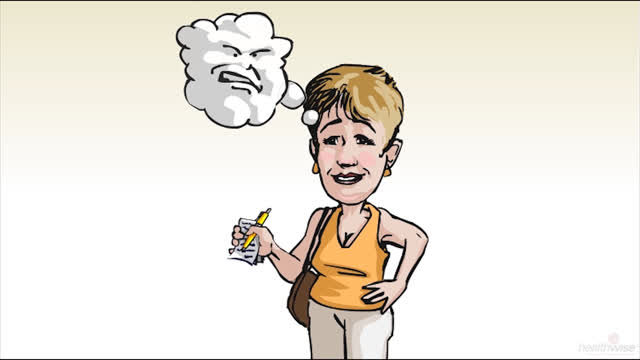Stop Negative Thoughts: Choosing a Healthier Way of Thinking
Topic Overview
What is healthy thinking?
Healthy thinking can teach you to know what thoughts of yours—both helpful and not helpful—affect problems or feelings that trouble you. With practice, you can learn to use accurate thoughts that encourage you instead of negative thoughts that discourage you.
If you stop negative thoughts, you may be more able to care for yourself and handle life’s challenges. You will feel better. And you may be more able to avoid or cope with stress, anxiety, sleep problems, unwanted weight gain, or depression.
Healthy thinking also involves calming your mind and body. You can use one or more techniques. These may include meditation, yoga, muscle relaxation, or guided imagery.
Cognitive-behavioral therapy, also called CBT, is a therapy that is often used to help people think in a healthy way. It focuses on thought (cognitive) and action (behavioral). Many people work with a therapist or a counselor to learn CBT. But you also can practice healthy thinking on your own.
How does CBT help you think in a healthy way?
CBT involves techniques that you can practice every day so that healthy thinking comes naturally. For example: Maybe you’re upset about a job review at work. Your boss praised several things about your work. But you’re feeling down because she had one small criticism. You might even think, “I’m no good at my job.” or “She doesn’t like me. I must be bad.”
Focusing on only the bad is an example of negative or distorted thinking. You can teach yourself to watch for negative thinking. You can ask yourself how true or helpful your thoughts were. “What did my boss say exactly?” “Were there positive comments?” “Why do I focus only on one criticism?”
You can learn to see that the harsh things you say to yourself may keep you from noticing the positive parts of your life and work. With time and practice, you can learn to tell yourself more accurate and helpful statements. You might say, “I’ve done a lot of good work this year, and my boss noticed it. She thought there was one area I can improve. So I’ll think of some things I can do to get stronger in that area.”
CBT combines several ways to help you change how you think:
- You learn to notice irrational thoughts about yourself.
- You learn to stop the thoughts.
- You learn to replace the negative thoughts with accurate thoughts.
- You can learn to relax your mind and body. This can lower your stress.
- You can learn to manage your time better. This also can lower your stress.
Although you can use CBT on your own, it’s important to talk to your doctor or a counselor if you have symptoms of depression or feel that your mood is getting worse.
How can you get started doing CBT on your own?
Learn to stop discouraging yourself with negative thoughts:
Learn how to use healthy thinking to prevent or treat some health problems:
Learn how to lower your stress:
- Stress Management: Doing Progressive Muscle Relaxation
- Stress Management: Managing Your Time
- Stress Management: Reducing Stress by Being Assertive
- Stress Management: Breathing Exercises for Relaxation
- Stress Management: Doing Guided Imagery to Relax
- Stress Management: Doing Meditation
- Stress Management: Practicing Yoga to Relax
How can a counselor help with CBT? How do you find one?
If you work with a counselor or a therapist, he or she can coach you to do CBT methods on your own.
There is no special license to show that a counselor has trained in CBT. You need to ask about a counselor’s knowledge of CBT.
Try to find two or three counselors who are licensed by your state. Ask your doctor and family or close friends if they can recommend someone. Licensed counselors may have a doctorate (a Ph.D.) in psychology or a master’s degree in social work or counseling.
You can call the counselors for a brief phone interview. Ask them if they have training in CBT and if they use it often.
Pick the counselor you feel most comfortable with.
For more information, see:
Health Tools
Health Tools help you make wise health decisions or take action to improve your health.
- Anxiety: Stop Negative Thoughts
- Depression: Stop Negative Thoughts
- Stop Negative Thoughts: Getting Started
- Stress Management: Breathing Exercises for Relaxation
- Stress Management: Doing Guided Imagery to Relax
- Stress Management: Doing Meditation
- Stress Management: Doing Progressive Muscle Relaxation
- Stress Management: Managing Your Time
- Stress Management: Practicing Yoga to Relax
- Weight Management: Stop Negative Thoughts
References
Other Works Consulted
- Hart SL, Hart TA (2010). The future of cognitive behavioral interventions within behavioral medicine. Journal of Cognitive Psychotherapy: An International Quarterly, 24(4): 344–353.
- Layous K et al. (2011). Delivering happiness: Translating positive psychology intervention research for treating major and minor depressive disorders. Journal of Alternative and Complementary Medicine, 17(8): 675–683.
- Lightsey OR, et al. (2012). Can positive thinking reduce negative affect? A test of potential mediating mechanisms. Journal of Cognitive Psychotherapy: An International Quarterly, 26(1): 71–88.
- McKay M, et al. (2011). Changing patterns of limited thinking. In Thoughts and Feelings: Taking Control of Your Moods and Your Life, 4th ed., pp. 27–45. Oakland, CA: New Harbinger.
- McKay M, et al. (2011). Coping with panic. In Thoughts and Feelings: Taking Control of Your Moods and Your Life, 4th ed., pp. 85–104. Oakland, CA: New Harbinger.
- McKay M, et al. (2011). Uncovering automatic thoughts. In Thoughts and Feelings: Taking Control of Your Moods and Your Life, 4th ed., pp. 15–25. Oakland, CA: New Harbinger.
- Newman CF, Beck AT (2009). Cognitive therapy. In BJ Sadock et al., eds., Kaplan and Sadock’s Comprehensive Textbook of Psychiatry, 9th ed., vol 2., pp. 2857–2873. Philadelphia: Lippincott Williams and Wilkins.
Current as of: May 28, 2019
Author: Healthwise Staff
Medical Review:Catherine Devany Serio, PhD – Psychology, Behavioral Health & Kathleen Romito, MD – Family Medicine & Christine R. Maldonado, PhD – Behavioral Health
This information does not replace the advice of a doctor. Healthwise, Incorporated, disclaims any warranty or liability for your use of this information. Your use of this information means that you agree to the Terms of Use. Learn how we develop our content.





